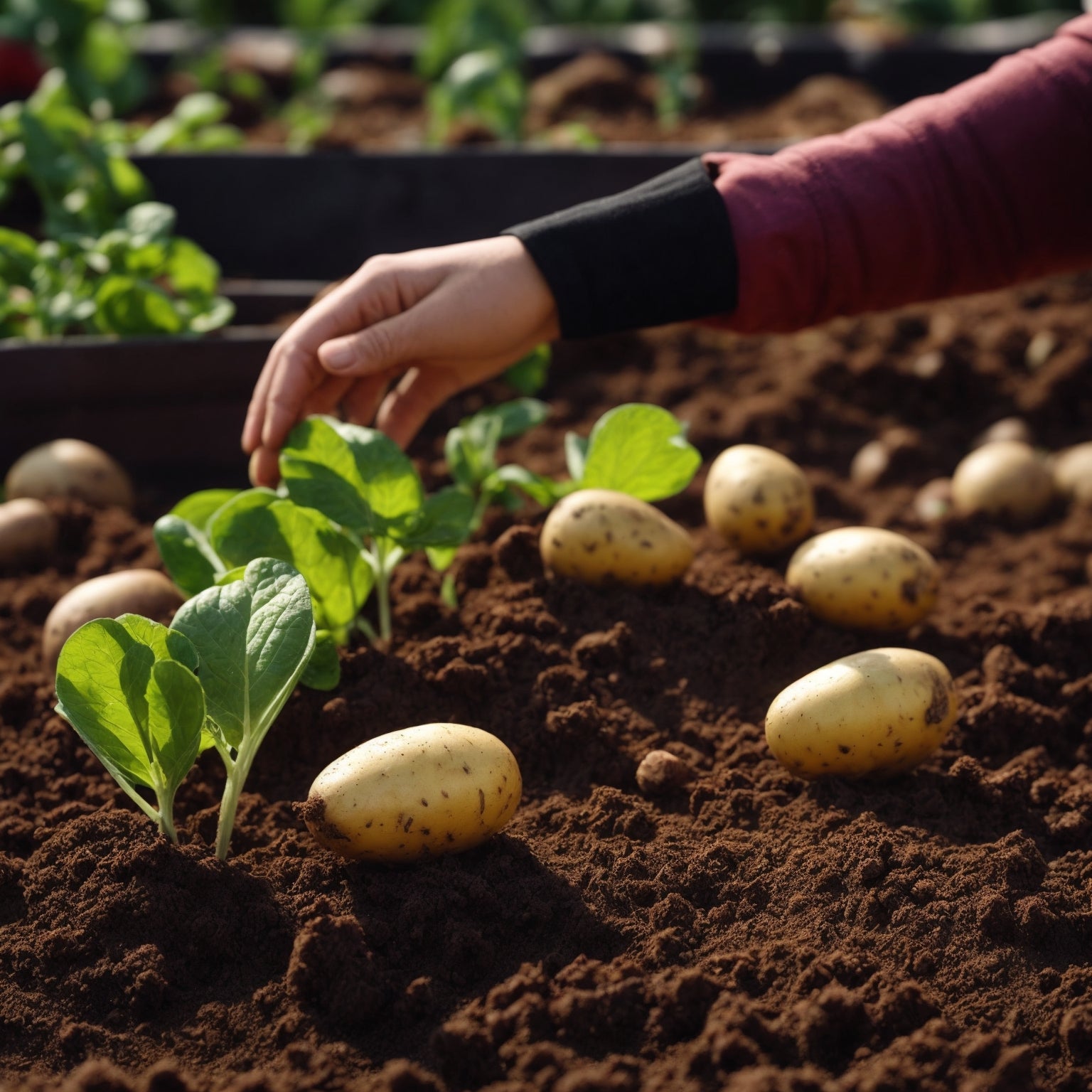Seed Potatoes

Seed Potatoes 1
Don’t Get Left without Seed Potatoes in Spring!!
Be prepared for Spring 2024 and order your seed potatoes now, and have them delivered early in 2024 just in time for planting. Delivery will begin in February 2024
Please Note: These are a pre season item and as such, if you are ordering other items along with the pre season Seed Potatoes, all will be delivered with the seed potatoes
Growing Your Own Food is one of the most rewarding things that you can do in the garden. Growing edible plants such as Seed Potatoes and other kitchen favourites is easy, all it requires is soil, sunlight, water and a good shake of tlc.
Starting off seed potatoes with the first earlies during early spring through to Second Earlies and Main Crop will ensure that you are harvesting your own, freshest of home grown food throughout the summer and into autumn.
The potato has been a mainstay of Irish cuisine for centuries and today this much loved root vegetable is making a comeback in home gardens. There are many different varieties of seed potatoes to choose from:
First Earlies Seed Potatoes:
- Home Guard - My favourite early potato, firm and full of flavour when cooked. This perfect all rounder has a short dormancy period making them very early on harvesting. A high yielding, short oval tubered variety that has white skins and a white creamy-floury textured flesh that give an excellent flavour. This wartime variety was introduced in 1942 and is still as popular within the kitchen today as it was then.
- Orla - A blight-resistant salad Cream skin and pale yellow flesh. Although it's a first early variety, it can also be grown as a second early and early maincrop
- Duke Of York - early harvesting 'Heritage Potato' first bred in 1891 that as become famous for it's superb rich flavour. A cream skinned oval tuber with a light-yellow waxy flesh making them perfect for freshly boiled new potatoes or salads. The plant itself is lowing growing therefore making them suitable to be grown in windy gardens.
- Solist - Extremely early harvesting variety that produces high yields of medium sized round to oval shaped tubers that store well. Yellow skinned potatoes with a firm yellow flesh that are excellent served hot or cold with Salads.
Second Earlies Seed Potatoes varieties available:
- British Queens - One of the most popular of all. Full of flavour, floury texture, this 'Heritage Potato' is 125 years old and is widely grown for it's good yields, shape and delicious flavour. Short oval white skinned tubers with a white, floury texture will give rise to exceptional roast potatoes. A great general purpose potato in the kitchen.
- Charlotte - Excellent salad type new potato with good blight resistance. This 'classic' salad potato with their enticing fresh flavour are a kitchen essential for any cook. Numerous long, oval cream skinned tubers with a firm but waxy light-yellow flesh are delicious served either hot or cold. Excellent when boiled as they hold their shape well or used in salads.
- Nicola - Produces numerous long oval tubers with a cream skin and a waxy textured medium-yellow flesh with a mild, buttery flavour. They have excellent boiling qualities so are ideal cooked as either boiled new potatoes or eaten with salads. Can be eaten either hot or cold, with or without skins. Great for growing in pots and containers.
- Purple Rain - A purple skinned potato with a firm textured, purple flesh that has a enjoyable flavour. A great all round potato in the kitchen but ideal boiled or steamed. Good storage qualities.
Main crop Seed Potatoes:
-
- Arran Victory- This 'Heritage Variety' potato was first introduced in 1918 to help celebrate the end of World War One. Tall weed suppressing foliage produces a moderately high yield of Blue-Purple, smooth skinned oval tubers with very bright white floury flesh that is full of flavour.
- Cara - Extremely high yielding and vigorous variety that produces uniform, white skinned, short oval tubers with red eyes. A very popular and versatile potato within the kitchen for it's floury, sweet, mild flavoured cream flesh. Excellent disease and drought resistance and it's strong, bushy foliage prevents wind damage. Superb for baking.
- Desiree - An old favourite variety to grow because of it's resistance to drought, numerous tubers and early bulking capabilities. A kitchen essential for cooks with it's large, long oval tubers and distinguished red skins that have a floury, light-yellow flesh. A great all rounder but especially perfect for creamy tasting mash that has a unique taste. Perfect to grow in poor, heavy, clay-like soils.
- Dunbar Standard - A high yielding potato variety that grows particularly well in heavy soils with tall, vigorous foliage. This variety produces long, oval shaped tubers that have a bold, white skin and a cream, strong, earthy flavoured white flesh. They make particularly good jacket potatoes.
- Golden Wonder - My favourite Maincrop and one of the most popular. A 'Heritage Potato' variety first introduced in 1906 that still remains popular today due to it's very floury texture making it superb for baking, roasting or frying. Long oval tubers with a thick russet coloured skin and cream flesh provide a very rich flavour which intensifies upon storage.
- Kerrs PInk - One of the most popular of all. Pink skin and floury flesh. Short oval pink skinned tubers with cream flesh that has a very floury texture. Excellent for mash, roast and baking. Traditionally they are cooked with their skins left on.
- King Edward - One of the oldest varieties of potato still grown commercially today. It is believed that this 'Heritage Potato' varieties introduction coincided with the coronation of King Edward VII in 1902 and as so was named to commemorate this occasion. Numerous tubers per plant are produced of pink blushed, cream skinned oval potatoes with a cream floury flesh. A kitchen essential for roast potatoes to any cook as they are renowned for their light, fluffy texture that gives rise to a strong, aromatic flavour.
- Maris Piper - The most widely grown and best known variety of Main Crop potatoes. A great variety for beginners to grow and suitable for storage. High yielding with many tubers per plant of cream skinned oval tubers that have a cream, floury textured flesh. A kitchen essential for any cook being a versatile all rounder and having a good, mild flavour. Superb for chips.
- Pentland Dell - This potato variety has a strong resistance against slugs and produces large white skinned tubers with a creamy-white flesh that has a firm but floury texture. Particularly suited for chips but can also bake well.
- Record - Oval, yellow potatoes, floury in texture. This classic floury textured potato variety is a popular choice amongst the crisp industry due to it's high dry matter. A yellow skinned potato with yellow flesh that has a great all round use in the kitchen. Use particularly for crisping and frying.
- Sarpo Mira - The most widely known and the highest resistant to blight variety from the 'Sarpo Family'. The 'potato of choice' for organic growers with their ability to grow well in a wide range of soils. Deep roots allow drought tolerance and tall weed suppressing foliage produce huge yields of long oval, pink skinned tubers that have a floury textured white flesh emitting a strong, aromatic potato taste. A good all round use in the kitchen but perfect for baking and mash. Excellent long term storage potential.
- Rooster – Red skinned variety with yellow flesh. A floury potato, good for baking, roasting, boiling, mashing and chipping.
No matter which variety you pick it is important to be realistic about the space you want to give up in your garden and the amount of each variety you have room to store or want to eat fresh.
One of the best varieties to start with is Sarpo as it is completely resistant to potato blight a real scourge in our climate.
For a successful potato crop you will need to set aside a large plot of nutrient rich soil somewhere in your garden that enjoys full sunshine.
No matter the Seed Potato you choose, it is worthwhile to sprout your seed potatoes before planting them as this speeds up the harvest time by as much as three weeks. To sprout your potatoes place the tubers (one deep) in soil and leave them to rest in a greenhouse or on a warm, sunlit windowsill until they begin to sprout. When your tubers are approximately 2.5 cm long they are ready to plant.
Potatoes are relatively easy to grow but first it is important to prepare the soil by digging nutrient rich organic matter or the plant based and organic, Nature Safe Granular Plant Food into trenches.
Plant your sprouted tubers (shoots pointing up) and keep the new plants well watered. Keep an eye on your potatoes and notice when shoots start to appear. Earth up around the shoots as they grow so that only the very tip of the shoot is visible.
First Earlies Seed Potatoes can be planted from January to March. Planting potatoes this early means you will be harvesting from May to July, but beware of frost as this will damage the young plants.
Second Earlies Seed Potatoes should be planted from February to April for harvesting in June onwards.
If you don’t have a lot of space in your garden for seed potatoes then you should concentrate on the earlier types because they can be planted closer together (30–40 cm apart in rows that are approx 40–50 cm apart) and are less likely to suffer from blight and other disease.
Early Seed Potatoes are ready 15–16 weeks after planting.
Maincrop Seed Potatoes are the most common varieties and although they take up the most space in the garden they are the best varieties to store.
The traditional planting time for Maincrop Seed Potatoes is anytime after St Patrick's Day, 17th March and these can be harvested 18–20 weeks after planting (August through to late September).
Be careful to store your potatoes correctly in a cool dry place to prevent them from going bad.
There are a few basic tips that will help ensure you have a healthy potato crop:
- Don’t overwater,
- Don’t plant tomato plants next to your potatoes as they are affected by the same blight,
- Always remove infected or dead potato plants from the garden
- And for sure results, plant a blight resistant variety such as Sarpo
Your potatoes are ready when they start to flower – harvest and enjoy.







